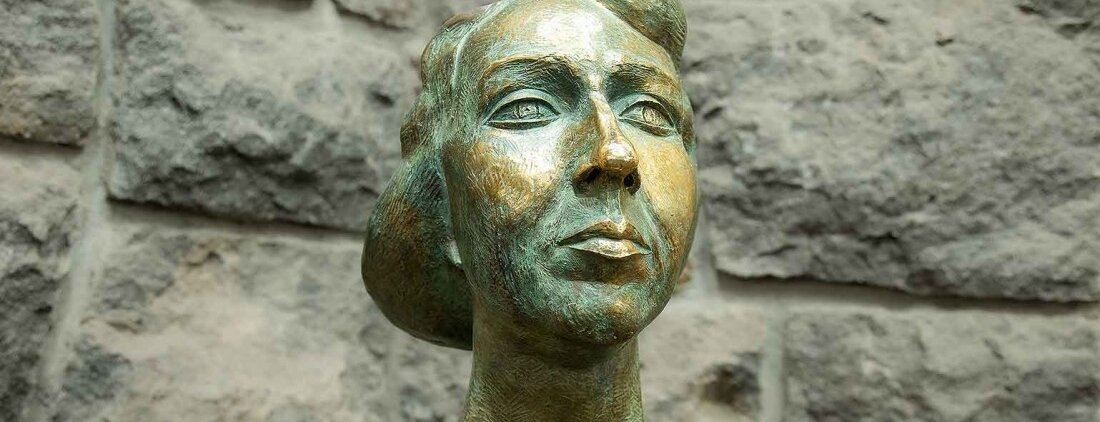
5 / Rachael Griffin Historic Exhibition Center
The lodge’s centered hexagonal stone chimney welcomes you straight ahead from the front entrance with a wooden location sign. Carved with Timberline’s iconic font, this sign will help guide you to all outlets of the lodge.
Mountain-inspired curved arches, known as the “Timberline Arch,” feature the Cascadian architecture style of the lodge that embraces volcanic stone with dense wood beams, brackets and wrought-iron straps. Emphasizing the pioneer wagon wheel, sturdy spoke-like beams of fir and pine extend the solid ceiling structure above. Using large cut stone, 8-10 mason workers built the enormous fireplace. 800,000 pounds of andesite stone reaches a total of 92 feet and was built within a wood frame during the winter of 1936-37. Rawhide seats around the fireplace were originally designed to be used by skiers in wet ski gear.
Curator of the Portland Art Museum, Rachael Griffin (1906-83) developed the concept of this lower lobby that was once the main ski lounge. It now features examples of wrought-iron works on a panel and floor area. Ironworks can be found everywhere throughout the lodge. During construction, the WPA blacksmiths would make all of the ironworks in a Portland shop with forge, anvil and hand-held tools. Requiring almost no casting, no pneumatic hammer or acetylene torch, the pieces were strictly handwork done mostly on the raw ingots. The spiral andirons of each fireplace, as well as the boot scrapers, are recycled railroad rails. After completion of lodge construction, the snow chains from the trucks were turned into fireplace screens still used today in the Lower Lobby and Main Lobby.
The carved Indian-inspired designs in the lintels around the lobby were taken from “The Year in Moons” of the Camp Fire Girls handbook. Follow the back wall of the exhibition center for more displays. A replica of a fireplace guest room features vintage skis, clothing, oil paintings and the original chair made for President Franklin D Roosevelt used during his 1937 dedication event. Griffin is portrayed in a bronze casting display made by Portland sculptor, Manuel Izquierdo.
The back right corner of the exhibition center highlights a timeline. The corner’s hidden nook, called “The Coyote Den,” is a quaint sitting area with more arch-shaped wood chairs, vintage photographs, wrought-iron works, books and photographs. The original landscape plan is displayed here, too. Typically, the video, The Builders of Timberline, is showing in The Coyote Den.
Civilian Conservation Corps (C.C.C.) uniforms and blankets were recycled, hooked and handwoven into rugs and wall hangings for the lodge. Some are displayed in cases here along the ground floor hallways. A display loom with cloth scraps sit next to the US Forest Service (USFS) desk. Here, you can look at a Mt Hood topographic map and use your smartphone to scan area trailhead information that are posted on the adjacent easel during the summer months. The Timberline Ski Area trail map is on display at the easel yearlong.
Wrought iron hardware, spiral andirons, door latches, furniture frames and boot scrapers by WPA blacksmith shop workers.
Bronze casting, Rachael Griffin, by Manuel Izquierdo
Oil painting, Untitled (Human Figures), by Howard S. Sewall, 1938.
Oil painting, Untitled (Sawmill), by Erich Lamade, 1933.
Watercolor painting, Landscape Plan for Timberline, by Emmet Blanchfield, 1937
Hooked rugs—Wagon Wheel, Wave, Zigzag, by WPA textile artists, 1937-38.
LOCATION: FRONT ENTRANCE GROUND FLOOR
WOOD - IRON - TEXTILES - FURNITURE